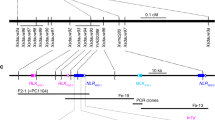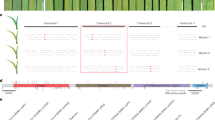Abstract
Fusarium head blight (FHB), which is mainly caused by Fusarium graminearum, is a destructive wheat disease that threatens global wheat production. Fhb1, a quantitative trait locus discovered in Chinese germplasm, provides the most stable and the largest effect on FHB resistance in wheat. Here we show that TaHRC, a gene that encodes a putative histidine-rich calcium-binding protein, is the key determinant of Fhb1-mediated resistance to FHB. We demonstrate that TaHRC encodes a nuclear protein conferring FHB susceptibility and that a deletion spanning the start codon of this gene results in FHB resistance. Identical sequences of the TaHRC-R allele in diverse accessions indicate that Fhb1 had a single origin, and phylogenetic and haplotype analyses suggest that the TaHRC-R allele most likely originated from a line carrying the Dahongpao haplotype. This discovery opens a new avenue to improve FHB resistance in wheat, and possibly in other cereal crops, by manipulating TaHRC sequence through bioengineering approaches.
This is a preview of subscription content, access via your institution
Access options
Access Nature and 54 other Nature Portfolio journals
Get Nature+, our best-value online-access subscription
$29.99 / 30 days
cancel any time
Subscribe to this journal
Receive 12 print issues and online access
$209.00 per year
only $17.42 per issue
Buy this article
- Purchase on Springer Link
- Instant access to full article PDF
Prices may be subject to local taxes which are calculated during checkout




Similar content being viewed by others
Data availability
RNA-seq data are available from the NCBI Sequence Read Archive under accession PRJNA515933. Additional data generated or analyzed during this study are included in this article and its supplementary information files.
References
Buerstmayr, H., Ban, T. & Anderson, J. A. QTL mapping and marker‐assisted selection for Fusarium head blight resistance in wheat: a review. Plant Breed. 128, 1–26 (2009).
Bai, G. & Shaner, G. Management and resistance in wheat and barley to Fusarium head blight. Annu. Rev. Phytopathol. 42, 135–161 (2004).
Xu, X. & Nicholson, P. Community ecology of fungal pathogens causing wheat head blight. Annu. Rev. Phytopathol. 47, 83–103 (2009).
Dean, R. et al. The top 10 fungal pathogens in molecular plant pathology. Mol. Plant Pathol. 13, 414–430 (2012).
Pestka, J. J. & Smolinski, A. T. Deoxynivalenol: toxicology and potential effects on humans. J. Toxicol. Environ. Health B Crit. Rev. 8, 39–69 (2005).
van Egmond, H. P., Schothorst, R. C. & Jonker, M. A. Regulations relating to mycotoxins in food. Anal. Bioanal. Chem. 389, 147–157 (2007).
Pestka, J. J. Deoxynivalenol: mechanisms of action, human exposure, and toxicological relevance. Arch. Toxicol. 84, 663–679 (2010).
McMullen, M. et al. A unified effort to fight an enemy of wheat and barley: Fusarium head blight. Plant Dis. 96, 1712–1728 (2012).
Chakraborty, S. & Newton, A. C. Climate change, plant diseases and food security: an overview. Plant Pathol. 60, 2–14 (2011).
Del Ponte, E. M., Fernandes, J., Pavan, W. & Baethgen, W. E. A model‐based assessment of the impacts of climate variability on Fusarium head blight seasonal risk in southern Brazil. J. Phytopath. 157, 675–681 (2009).
Zhang, X. et al. Climate change increases risk of Fusarium ear blight on wheat in central China. Ann. Appl. Biol. 164, 384–395 (2014).
Cuthbert, P. A., Somers, D. J., Thomas, J., Cloutier, S. & Brulé-Babel, A. Fine mapping Fhb1, a major gene controlling Fusarium head blight resistance in bread wheat (Triticum aestivum L.). Theor. Appl. Genet. 112, 1465–1472 (2006).
Yang, Z. P. et al. Marker assisted selection of Fusarium head blight resistance genes in two doubled haploid populations of wheat. Mol. Breed. 12, 309–317 (2003).
Zhou, W., Kolb, F. L., Bai, G., Shaner, G. & Domier, L. L. Genetic analysis of scab resistance QTL in wheat with microsatellite and AFLP markers. Genome 45, 719–727 (2002).
Anderson, J. A. et al. DNA markers for Fusarium head blight resistance QTLs in two wheat populations. Theor. Appl. Genet. 102, 1164–1168 (2001).
Waldron, B., Moreno-Sevilla, B., Anderson, J., Stack, R. & Frohberg, R. RFLP mapping of QTL for Fusarium head blight resistance in wheat. Crop Sci. 39, 805–811 (1999).
Bai, G., Kolb, F. L., Shaner, G. & Domier, L. L. Amplified fragment length polymorphism markers linked to a major quantitative trait locus controlling scab resistance in wheat. Phytopathology 89, 343–348 (1999).
Pumphrey, M. O., Bernardo, R. & Anderson, J. A. Validating the QTL for Fusarium head blight resistance in near-isogenic wheat lines developed from breeding populations. Crop Sci. 47, 200–206 (2007).
Bernardo, A. N., Ma, H., Zhang, D. & Bai, G. Single nucleotide polymorphism in wheat chromosome region harboring Fhb1 for Fusarium head blight resistance. Mol. Breed. 29, 477–488 (2012).
Jin, F. et al. Fusarium head blight resistance in US winter wheat cultivars and elite breeding lines. Crop Sci. 53, 2006–2013 (2013).
Schweiger, W. et al. Suppressed recombination and unique candidate genes in the divergent haplotype encoding Fhb1, a major Fusarium head blight resistance locus in wheat. Theor. Appl. Genet. 129, 1607–1623 (2016).
Rawat, N. et al. Wheat Fhb1 encodes a chimeric lectin with agglutinin domains and a pore-forming toxin-like domain conferring resistance to Fusarium head blight. Nat. Genet. 48, 1576–1580 (2016).
Yang, J., Bai, G. & Shaner, G. E. Novel quantitative trait loci (QTL) for Fusarium head blight resistance in wheat cultivar Chokwang. Theor. Appl. Genet. 111, 1571–1579 (2005).
Paux, E. et al. A physical map of the 1-gigabase bread wheat chromosome 3B. Science 322, 101–104 (2008).
Choulet, F. et al. Megabase level sequencing reveals contrasted organization and evolution patterns of the wheat gene and transposable element spaces. Plant Cell 22, 1686–1701 (2010).
Hofstad, A. N. et al. Examining the transcriptional response in wheat near-isogenic lines to infection and deoxynivalenol treatment. Plant Genome 9, 1 (2016).
Jia, H., Cho, S. & Muehlbauer, G. J. Transcriptome analysis of a wheat near-isogenic line pair carrying Fusarium head blight-resistant and -susceptible alleles. Mol. Plant-Microbe Inter. 22, 1366–1378 (2009).
Wu, L. et al. Stripe rust resistance gene Yr18 and its suppressor gene in Chinese wheat landraces. Plant Breed. 134, 634–640 (2015).
Lin, F. et al. Mapping QTL associated with resistance to Fusarium head blight in the Nanda2419 × Wangshuibai population. I: Type II resistance. Theor. Appl. Genet. 109, 1504–1511 (2004).
White, P. J. & Broadley, M. R. Calcium in plants. Annu. Bot. 92, 487–511 (2003).
Wang, Y. et al. Simultaneous editing of three homoeoalleles in hexaploid bread wheat confers heritable resistance to powdery mildew. Nat. Biotechnol. 32, 947–951 (2014).
Fukuoka, S. et al. Loss of function of a proline-containing protein confers durable disease resistance in rice. Science 325, 998–1001 (2009).
Faris, J. D. et al. A unique wheat disease resistance-like gene governs effector-triggered susceptibility to necrotrophic pathogens. Proc. Natl Acad. Sci. USA 107, 13544–13549 (2010).
Shi, G. et al. The hijacking of a receptor kinase-driven pathway by a wheat fungal pathogen leads to disease. Sci. Adv. 2, e1600822 (2016).
van Schie, C. C. & Takken, F. L. Susceptibility genes 101: how to be a good host. Annu. Rev. Phytopathol. 52, 551–581 (2014).
Kugler, K. G. et al. Quantitative trait loci-dependent analysis of a gene co-expression network associated with Fusarium head blight resistance in bread wheat (Triticum aestivum L.). BMC Genomics 14, 1 (2013).
Kang, J. et al. Exotic scab resistance quantitative trait loci effects on soft red winter wheat. Crop Sci. 51, 924–933 (2011).
Tamura, K. et al. MEGA5: molecular evolutionary genetics analysis using maximum likelihood, evolutionary distance, and maximum parsimony methods. Mol. Biol. Evol. 28, 2731–2739 (2011).
Bai, G. H., Shaner, G. & Ohm, H. Inheritance of resistance to Fusarium graminearum in wheat. Theor. Appl. Genet. 100, 1–8 (2000).
Martin, M. Cutadapt removes adapter sequences from high-throughput sequencing reads. EMBnet J. 17, 10–12 (2011).
Pearson, W. R., Wood, T., Zhang, Z. & Miller, W. Comparison of DNA sequences with protein sequences. Genomics 46, 24–36 (1997).
Wu, T. D. & Watanabe, C. K. GMAP: a genomic mapping and alignment program for mRNA and EST sequences. Bioinformatics 21, 1859–1875 (2005).
International Wheat Genome Sequencing Consortium (IWGSC). A chromosome-based draft sequence of the hexaploid bread wheat (Triticum aestivum) genome. Science 345, 1251788 (2014).
Trapnell, C. et al. Transcript assembly and quantification by RNA-seq reveals unannotated transcripts and isoform switching during cell differentiation. Nat. Biotechnol. 28, 511–515 (2010).
Miki, D. & Shimamoto, K. Simple RNAi vectors for stable and transient suppression of gene function in rice. Plant Cell Physiol. 45, 490–495 (2004).
Cruz, L. F., Rupp, J. L. S., Trick, H. N. & Fellers, J. P. Stable resistance to wheat streak mosaic virus in wheat mediated by RNAi. In Vitro Cell. Dev. Biol. Plant 50, 665–672 (2014).
Christensen, A. H. & Quail, P. H. Ubiquitin promoter-based vectors for high-level expression of selectable and/or screenable marker genes in monocotyledonous plants. Trans. Res. 5, 213–218 (1996).
Anand, A., Trick, H. N., Gill, B. S. & Muthukrishnan, S. Stable transgene expression and random gene silencing in wheat. Plant Biotechnol. J. 1, 241–251 (2003).
Zhai, Z., Sooksa-nguan, T. & Vatamaniuk, O. K. Establishing RNA interference as a reverse-genetic approach for gene functional analysis in protoplasts. Plant Physiol. 149, 642–652 (2009).
Acknowledgements
This project was supported by US Department of Agriculture US Wheat and Barley Scab Initiative and National Research Initiative competitive grants 2017-67007-25939 and 2017-67007-25929 from the USDA National Institute of Food and Agriculture. We thank W. Wang for excellent technical support. Mention of trade names or commercial products in this publication is solely for the purpose of providing specific information and does not imply recommendation or endorsement by the US Department of Agriculture. USDA is an equal opportunity provider and employer. This is contribution number 16-129-J from the Kansas Agricultural Experiment Station.
Author information
Authors and Affiliations
Contributions
G.B. designed the research. Z.S., A.B., B.T., H.M., H.C., S.C., D.Z. and T.L. performed the research with support from G.B., H.T. and P.S.A. D.L., J.Y., Z.Z. and S.W. analyzed data. G.B. and H.T. contributed new reagents and analytic tools. G.B. and Z.S. wrote the paper. All authors contributed to revision of the manuscript.
Corresponding author
Ethics declarations
Competing interests
The authors declare no competing interests.
Additional information
Publisher’s note: Springer Nature remains neutral with regard to jurisdictional claims in published maps and institutional affiliations.
Supplementary information
Supplementary Information
Supplementary Figs. 1–11
Supplementary Table 1
Primers used for fine mapping, gene cloning, association mapping, diagnostic marker development and gene transformation
Supplementary Table 2
A list of genes in the Fhb1 region based on the reference sequence of Chinese Spring and CM82036
Supplementary Table 3
Differentially expressed genes between Fhb1 NILs that were identified by RNA-seq and mapped on chromosome 3B
Supplementary Table 4
List of names, identification numbers (IDs), sources of wheat accessions and sequence polymorphisms in TaHRC
Supplementary Table 5
Haplotype distribution of the three candidate genes across 1,632 wheat accessions from 73 countries worldwide
Supplementary Table 6
Comparison of FHB resistance among haplotypes Hap_Ning, Hap_DHP and Hap_ND
Rights and permissions
About this article
Cite this article
Su, Z., Bernardo, A., Tian, B. et al. A deletion mutation in TaHRC confers Fhb1 resistance to Fusarium head blight in wheat. Nat Genet 51, 1099–1105 (2019). https://doi.org/10.1038/s41588-019-0425-8
Received:
Accepted:
Published:
Issue Date:
DOI: https://doi.org/10.1038/s41588-019-0425-8



